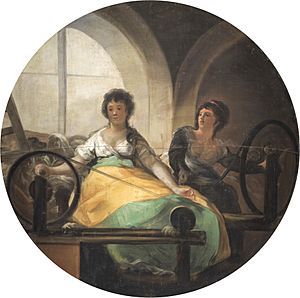Allegory of Industry facts for kids
Quick facts for kids Allegory of Industry |
|
|---|---|
| Spanish: Alegoría de la Industria | |
 |
|
| Artist | Francisco de Goya |
| Year | c. 1805 |
| Medium | Tempera on canvas |
| Dimensions | 227 cm diameter (89 in) |
| Location | Museo del Prado, Madrid |
The `Allegory of Industry` is a special round painting, called a tondo, created by the famous Spanish artist Francisco de Goya around 1805. This artwork was part of a series of four paintings. These paintings were like visual stories, known as allegories, that showed ideas about science and how countries grow economically. The series included paintings about agriculture, trade, and science (though the science one is now lost).
These paintings were made to decorate a waiting room in the home of Manuel Godoy. He was a very important person at the time, serving as the Prime Minister of Spain when King Charles IV was in charge. Since 1932, the `Allegory of Industry` has been kept and displayed at the Museo del Prado in Madrid, Spain.
Contents
What is an Allegory?
An allegory is a story, poem, or picture that can be understood to reveal a hidden meaning. This meaning is often a moral or political one. In art, an allegory uses symbols or characters to represent ideas or qualities. For example, a figure holding a balance scale might represent justice. Goya's paintings used allegories to show big ideas like industry, agriculture, and trade.
About the Painting
The `Allegory of Industry` shows two young women working with spinning wheels. They are in a room that is not very bright, but a large window on the left side lets in some light. This light helps us see the women and their work clearly.
The Scene in the Painting
- Two Young Women: They are the main focus, busy with their spinning wheels. Spinning wheels were important tools for making thread from materials like wool or cotton. This work was a key part of industry before large factories became common.
- The Light: The way light comes into the room is important. It highlights the work of the young women, suggesting that their efforts are valuable and bring progress.
- Figures in the Background: If you look closely in the darker parts of the room, you might see some unclear faces of older women. Some art experts think these could represent the Fates. The Fates were figures in ancient Greek myths who were believed to control people's destiny and the thread of life. It's not completely clear if these figures are just other workers or if they have a deeper symbolic meaning related to destiny or the passage of time.
Industry and Progress
Goya's painting celebrates the idea of "industry." In his time, this meant hard work, skill, and the production of goods. It was a period when new ways of making things were developing, leading towards what we now call the Industrial Revolution. By showing women at spinning wheels, Goya highlights the importance of textile production and the labor that drove economic growth. The painting suggests that industry is a positive force, bringing wealth and progress to a nation.
Goya and His Time
Francisco de Goya was a leading Spanish artist of his era. He lived during a time of big changes in Spain and Europe. His art often reflected the society around him, from royal portraits to scenes of everyday life and even dark, imaginative works. The `Allegory of Industry` shows his interest in the ideas of the Enlightenment, a period when people believed in the power of reason, science, and human progress.
See also
 In Spanish: Alegoría de la Industria para niños
In Spanish: Alegoría de la Industria para niños
- List of works by Francisco Goya

